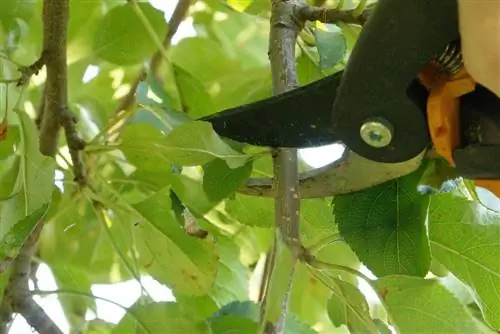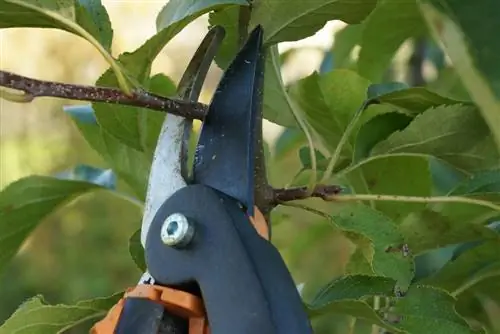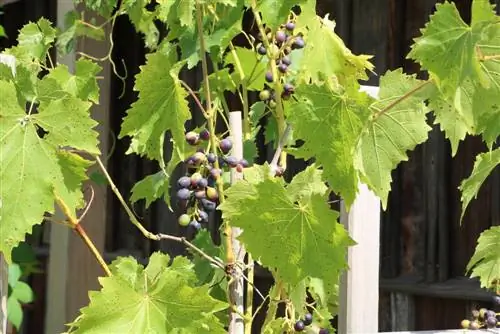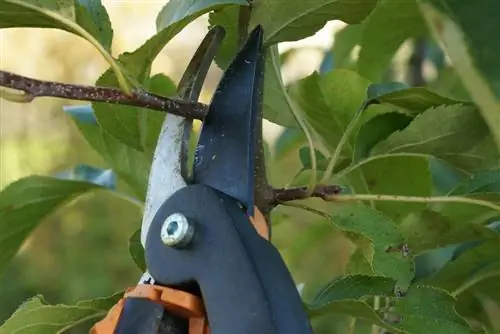- Author admin [email protected].
- Public 2023-12-17 03:39.
- Last modified 2025-01-24 12:45.
Autumn heralds the coming winter rest for many plants. So that the plants survive the winter optimally and sprout vigorously the following year, they should be prepared accordingly for the winter. Autumn pruning supports the plants and at the same time creates the optimal conditions for lush growth. But be careful: not all plants need or tolerate autumn pruning! In addition, under no circumstances should you cut randomly, as this could seriously damage the plants.
The optimal time
The earliest possible date for autumn pruning is October 1st. According to the Federal Nature Conservation Act, the radical cutting of trees and hedges is prohibited from March 1st to September 30th in order to protect breeding birds. It is therefore important to wait until October for the autumn cut. It is best to prune before the first frost. Because when the branches and twigs are cut off, wounds are created, which the plants should ideally heal and seal before the frost. Temperatures that are too low not only affect wound healing, but could also cause the wood to splinter. This in turn allows pests to penetrate the plant more easily and thus represents an additional burden or threat to it. In summary, the following conditions arise for the autumn pruning date:
- from October
- ideally before the first frost
- on the warmest, sunny day possible
- the temperature should be above 0 degrees
- Shrubs and trees planted in the same year do not require autumn pruning
What is cut off in autumn?
In general, it can be said that during autumn pruning all excess branches and twigs are first removed. These are primarily old and dead branches and leaves. In addition to the dead wood, all diseased branches and parts of plants should always be removed, as these are considered breeding grounds for fungi and other pathogens. Depending on the plant, it may also be necessary to remove additional branches and twigs. This particularly includes those shoots that do not bear any leaves or fruit. As a general rule, however, too many branches and twigs should never be removed. These serve as natural frost protection for the plant and sometimes offer animals safe shelter in the cold winter months. In summary, autumn pruning generally includes the following work steps:
- remove diseased and dead plant parts
- cut off old and weak branches
- remove excess side shoots
- cut off shoots that are too close and growing together
- shorten branches that have grown too long
Tip:
To reduce the risk of infections, it is advisable to always cut at an angle. Because this offers possible bacteria the least possible attack surface.
Autumn pruning of fruit trees
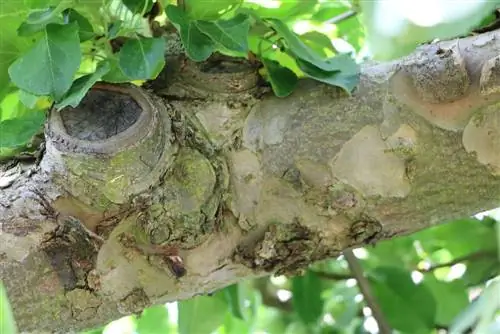
As soon as the tree has shed its leaves, it is the ideal time to cut it back. Although it is generally possible to prune trees in autumn at temperatures below zero degrees, the shoots could break or tear and the wood could become brittle. It is therefore advisable to carry out the pruning on a sunny, frost-free day. When cutting back, it is also important to ensure that the crown is as light as possible. This means that the foliage dries more quickly after rain, the air circulates better and the tree is less susceptible to fungal diseases. In addition to removing dead and diseased branches, autumn pruning of fruit trees includes the following:
Cut off water shoots
The water shoots are also called water shoots or water shoots by hobby gardeners. These are summer shoots made from old wood, which are usually located inside the tree crown. The water shoots arise from the so-called sleeping buds, whose task is to restore lost branches or twigs. A particularly large number of water shoots can often be seen on trees if they were pruned too heavily in the previous year. Since the water shoots do not bear any buds and thus cost the tree unnecessary energy, they are removed regularly as follows:
- fresh water shoots can usually be torn off
- alternatively the shoots are cut off
- It's best to cut it off directly at the branch string
- so that the water shoots don't sprout again immediately
Remove competitive instincts
The competing shoots are branches that threaten to overgrow the tip of the central shoot. On the one hand, this results in a malformation of the tree crown and, on the other hand, the growth of the tree is impaired. The competing shoots require a lot of energy, which the tree needs for growth and the formation of fruit. In addition, the competing shoots prevent optimal light from reaching the interior of the tree canopy, which particularly affects the fruits. Because when they grow in the shade, they usually have a smaller shape and a sour taste. Therefore, it is essential to remove the competitive instincts as follows:
- first consider the structure of the tree or redefine it
- usually there is one continuous central shoot
- and three to four lateral guide branches
- these should all be at the same height (juice scale)
- recognize and remove competitive instincts
- For thick branches, saw first from below and then from above
- then saw off the stump
Blending
As a rule, the treetop should be as light as possible, as this has several advantages. On the one hand, more light reaches the interior of the tree crown, which means that the foliage dries more quickly after rain. On the other hand, a crown that is as light as possible allows better air circulation, which makes the tree less susceptible to fungal diseases. In addition, the fruits also benefit from a sparse treetop because they receive more light, which in turn is noticeable in their shape and taste. Thinning out the crown is therefore an essential maintenance effort in which the following parts of the plant are removed:
- branches growing inwards
- branches growing too steeply upwards
- branches lying on top of each other
- branches rubbing against each other
Autumn pruning of perennials and shrubs

Whether the shrub needs autumn pruning depends primarily on the type of plant. As a rule, evergreen species, such as the cherry laurel hedge, do not require any pruning. These can be cut back, but the cut does not affect the intensity of the flowering. There are also shrubs that absolutely cannot tolerate autumn pruning, including laburnum, witch hazel and magnolia. The situation is different for the bushes that bloom in summer, because they need pruning in autumn.
This particularly includes fruit bushes, with blackberry and raspberry bushes in particular benefiting from this care measure. During autumn pruning, all old and diseased branches and twigs are first removed. It is also important to cut off the old shoots to the ground. These can usually be recognized by their color, because the older a shoot is, the darker it is. In addition, the following plant parts should be removed when pruning the bushes in autumn:
- shorten weak and sparse shoots
- shorten the branches that grow inwards and crosswise
- cut this off close to the main shoot
- This enables the supply of light and air
- also shorten shoots that are too close together
- Completely remove side shoots near the ground
Tip:
Since the strong shoots keep pushing to the top, they are only cut back a little. Thinner shoots, on the other hand, can be shortened without any problem.
The equipment you need
The use of special cutting tools not only simplifies the work of the hobby gardener, but also protects the plants. Blunt tools can cause injuries to the plants, which in turn increases the risk of infections. In addition, bacteria and pathogens can be transmitted through unclean tools. It is therefore essential to clean and, ideally, sterilize it before and after use. Plant juices and tree resin can be easily removed with a little oil, while dried residue can be removed with fine-grain sandpaper.
Once the tool is prepared for use, many hobby gardeners ask themselves which cutting tool they should use. The type of plant and the amount of work required must be taken into account in particular. Because pruning thick branches requires different equipment than cutting delicate branches of bushes. The following list of the required cutting tools provides an optimal overview:
Tree saw
In order to cut the thick branches of trees, particularly robust tools, such as a tree saw, are required. Folding saws and hacksaws have proven particularly useful for autumn pruning of trees.
- for particularly thick branches
- the thicker the branch, the coarser the teeth of the saw
- the finer the teeth, the smoother the cutting surface
- also available with cable pull or telescopic rods
- This means that particularly tall branches can also be cut
Anvil Scissors
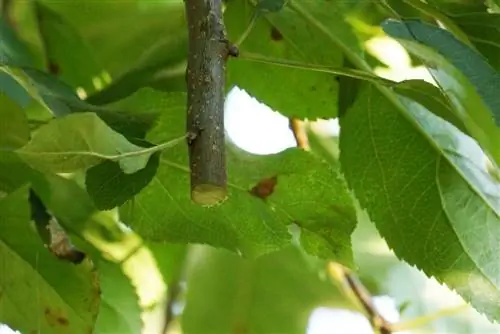
The anvil scissors only have one blade, which in turn hits a solid surface (called an anvil). Working with these scissors is extremely popular because comparatively little force is required. The disadvantage of these scissors, however, is that the branches are not cut off, but rather “squashed”. This makes it easier for the bark to split open, which in turn increases the risk of injury to the plant.
- Removing Dead Wood
- Cutting thicker branches
- suitable for both trees and shrubs
Bypass scissors
The bypass scissors, on the other hand, have a double-edged blade, which enables particularly clean and precise cuts. It is mostly used for cutting thinner clippings such as bushes or perennials.
- Pruning green wood
- Cutting thin branches and twigs
- is not suitable for trees, but rather for shrubs
Shrub shears
Using shrub shears is particularly worthwhile for dense hedges and bushes. These are also versatile and can be used to cut and artistically shape shrubs, bushes and boxwood.
- Shaping and cutting bushes
- Pruning of bushes and hedges
- Cutting medium-thick branches and shoots (note cutting thickness!)
Conclusion
Autumn pruning is an essential care measure for both shrubs and trees. Removing excess, diseased and dead branches ensures that the plants have enough strength for hibernation and will sprout lushly the following year.

